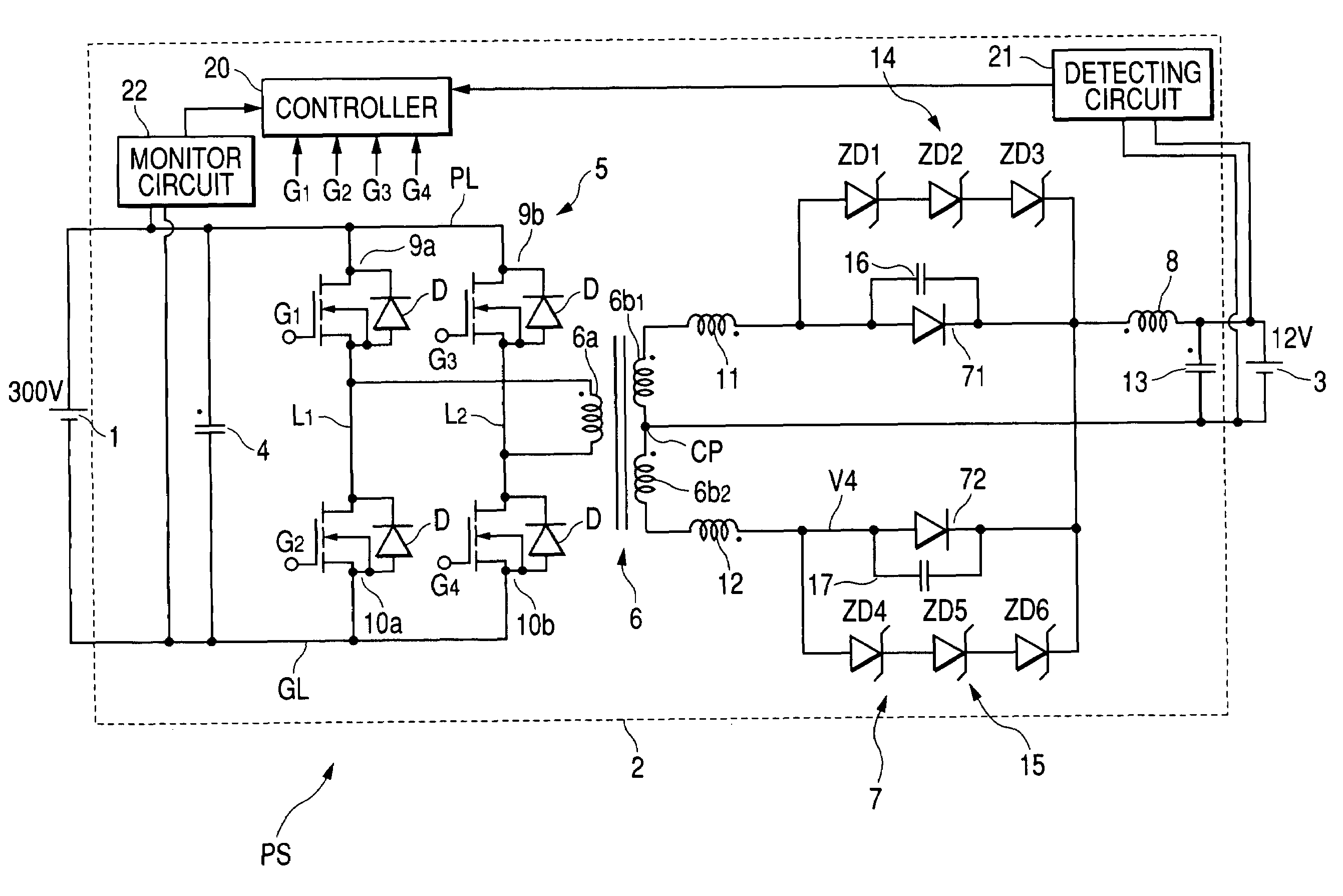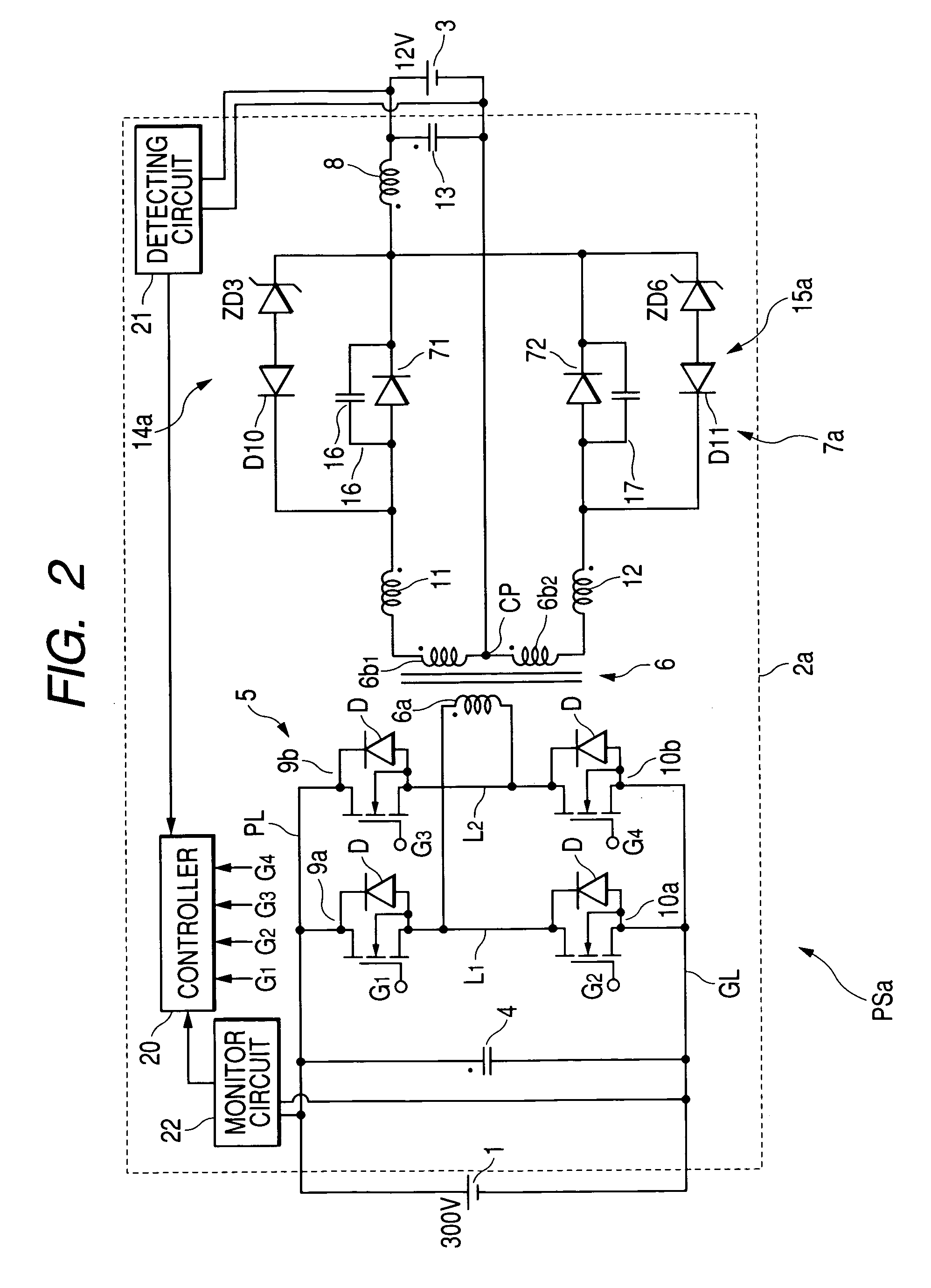Rectifying circuit
- Summary
- Abstract
- Description
- Claims
- Application Information
AI Technical Summary
Benefits of technology
Problems solved by technology
Method used
Image
Examples
first embodiment
[0019](First Embodiment)
[0020]FIG. 1 is a diagram illustrating a circuit structure of a power supply PS for vehicles, in which a DC—DC converter including a rectifying circuit according to a first embodiment of the present invention.
[0021]The power supply PS is provided with a high DC-voltage battery 1, such as 300V battery, a DC—DC converter 2 electrically connected thereto, and a low DC-voltage battery 3, such as 12V battery, which is electrically connected to the DC—DC converter 2.
[0022]For example, the high DC-voltage battery 1 is a high DC-voltage battery for traction units installed in the vehicle, and the low DC-voltage battery 3 is a low DC-voltage battery for auxiliary loads installed in the vehicle.
[0023]The DC—DC converter 2 includes an input-side smoothing capacitor 4, an inverter circuit 5, a step-down transformer 6, a rectifying circuit 7, a smoothing inductor 8, and an output-side smoothing capacitor 13.
[0024]The input-side smoothing capacitor 4 is electrically connec...
second embodiment
[0067](Second Embodiment)
[0068]FIG. 2 is a circuit diagram illustrating a circuit structure of a power supply PSa for vehicles, in which a DC—DC converter including a rectifying circuit according to a second embodiment of the present invention.
[0069]Incidentally, elements of the DC—DC converter according to the third embodiment, which are substantially identical with those of the power supply PS according to the first embodiment, are assigned to the same reference characteristics of the power supply PS shown in FIG. 1, and explanations thereabout are omitted or simplified. That is, specific points of the power supply PSa according to the second embodiment different from the power supply PS according to the first embodiment are focused.
[0070]As shown in FIG. 2, the power supply PSa includes a DC—DC converter 2a, and the DC—DC converter 2a is composed of a rectifying circuit 7a.
[0071]The rectifying circuit 7a, in place of the protection diode circuits 14 and 15, is composed of protec...
third embodiment
[0082](Third Embodiment)
[0083]FIG. 3 is a circuit diagram illustrating a circuit structure of a power supply PSb for vehicles, in which a DC—DC converter including a rectifying circuit according to a third embodiment of the present invention.
[0084]Incidentally, elements of the DC—DC converter according to the third embodiment, which are substantiality identical with those of the power supply PS according to the first embodiment, are assigned to the same reference characteristics of the power supply PS shown in FIG. 1, and explanations thereabout are omitted or simplified. That is, specific points of the power supply PSb according to the third embodiment different from the power supply PS according to the first embodiment are focused.
[0085]As shown in FIG. 3, the power supply PSb includes a DC—DC converter 2b, and the DC—DC converter 2b is composed of a rectifying circuit 7b.
[0086]The rectifying circuit 7b, in place of the rectifying diodes 71 and 72, is composed of synchronous rect...
PUM
 Login to View More
Login to View More Abstract
Description
Claims
Application Information
 Login to View More
Login to View More - R&D
- Intellectual Property
- Life Sciences
- Materials
- Tech Scout
- Unparalleled Data Quality
- Higher Quality Content
- 60% Fewer Hallucinations
Browse by: Latest US Patents, China's latest patents, Technical Efficacy Thesaurus, Application Domain, Technology Topic, Popular Technical Reports.
© 2025 PatSnap. All rights reserved.Legal|Privacy policy|Modern Slavery Act Transparency Statement|Sitemap|About US| Contact US: help@patsnap.com



